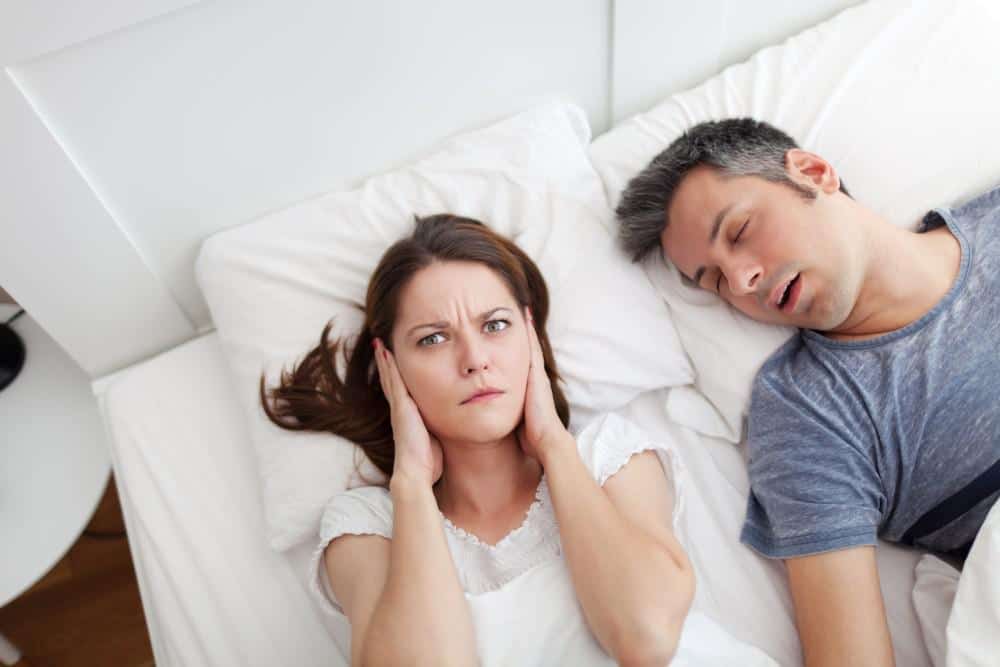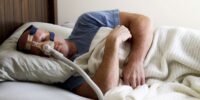What Is The Connection Between Sleep Apnea And Snoring?

Sleep apnea and snoring are two common sleep disorders that can have a significant impact on an individual’s overall health and well-being.
Sleep apnea is characterized by repeated pauses in breathing during sleep, which can lead to a range of symptoms and complications.
Snoring, on the other hand, is the noisy and often disruptive sound that occurs when airflow is partially blocked during sleep.
While snoring is a common symptom of sleep apnea, not everyone who snores has sleep apnea. However, there is a strong connection between the two conditions, as snoring is often a prominent symptom of sleep apnea.
Understanding the link between sleep apnea and snoring is crucial for proper diagnosis and treatment, as untreated sleep apnea can have serious risks and consequences.
This article will explore the connection between sleep apnea and snoring, the risks of untreated sleep apnea, diagnosis and treatment options, lifestyle changes to manage sleep apnea, alternative therapies, and strategies for managing sleep apnea and snoring at home.
Additionally, seeking professional help for sleep apnea will be discussed to ensure individuals receive the necessary support and treatment.
Key Takeaways
- Sleep apnea is characterized by pauses in breathing during sleep, while snoring is the noisy sound when airflow is partially blocked.
- Snoring is a common symptom of sleep apnea.
- Untreated sleep apnea can lead to serious risks and consequences, including cardiovascular diseases and metabolic disorders.
- Prompt diagnosis and treatment of sleep apnea are crucial to mitigate potential health issues.
Understanding Sleep Apnea
Sleep apnea is a sleep disorder characterized by pauses in breathing or shallow breathing during sleep, often accompanied by loud snoring. It is a serious condition that can lead to various health problems if left untreated.
There are three types of sleep apnea: obstructive sleep apnea (OSA), central sleep apnea (CSA), and complex sleep apnea syndrome (CSAS). OSA, the most common type, occurs when the muscles in the throat fail to keep the airway open, leading to brief interruptions in airflow.
CSA, on the other hand, is caused by a malfunction in the brain’s respiratory control center, which fails to send the proper signals to the muscles that control breathing. Lastly, CSAS is a combination of both OSA and CSA.
Snoring is a common symptom of sleep apnea, as it is a result of the narrowed or blocked airway. However, not everyone who snores has sleep apnea, and not everyone with sleep apnea snores. It is important to consult a healthcare professional for an accurate diagnosis and appropriate treatment.
The Link Between Sleep Apnea and Snoring
Snoring is a common symptom associated with sleep apnea. It is often characterized by loud, disruptive noises during sleep caused by the obstruction or narrowing of the airway.
Sleep apnea, a sleep disorder that affects breathing patterns, can lead to snoring as the muscles in the throat relax and block the airflow.
Snoring as a Common Symptom
Loud, disruptive noises that reverberate through the silence of the night often accompany the restless slumber of individuals experiencing sleep apnea.
Snoring, a commonly recognized symptom, is prevalent among those suffering from sleep apnea. Snoring occurs when the flow of air through the passages at the back of the throat becomes partially blocked during sleep, leading to the vibration of tissues and the production of sound.
In sleep apnea, this blockage becomes more severe, causing the airway to collapse and temporarily interrupting breathing. As a result, individuals with sleep apnea often snore loudly and frequently, with periods of silence followed by gasps or choking sounds as they momentarily cease breathing.
Snoring, therefore, serves as a key indicator of sleep apnea and is often one of the primary reasons individuals seek medical attention for their sleep-related issues.
How Sleep Apnea Causes Snoring
One of the primary mechanisms behind the production of disruptive nighttime noises can be attributed to the collapse and obstruction of the airway during sleep in individuals with sleep apnea. This condition, characterized by pauses in breathing throughout the night, can lead to snoring.
The connection between sleep apnea and snoring is as follows:
- Airway blockage: The collapse of the airway in sleep apnea restricts the flow of air, causing turbulence and vibrations that result in snoring sounds.
- Soft tissue vibration: When the airway becomes partially or completely blocked, the air passing through causes the soft tissues in the throat, such as the uvula and soft palate, to vibrate, leading to snoring.
- Increased effort to breathe: As the airway collapses, the individual with sleep apnea must exert more effort to inhale and exhale, resulting in higher airflow speeds and increased likelihood of snoring.
Understanding the connection between sleep apnea and snoring is crucial for diagnosing and treating these conditions effectively.
Risks and Consequences of Untreated Sleep Apnea
Untreated sleep apnea can have significant consequences on overall health. It has been found to increase the risk of developing various cardiovascular diseases, such as hypertension, stroke, and heart failure.
These risks arise from the intermittent oxygen deprivation and chronic sleep fragmentation that occur during sleep apnea episodes, leading to detrimental effects on the cardiovascular system.
Impact on Overall Health
The impact of sleep apnea on overall health extends beyond the disruption of sleep patterns and includes potential cardiovascular complications and increased risk of metabolic disorders.
Sleep apnea is characterized by frequent pauses in breathing during sleep, resulting in decreased oxygen levels and increased carbon dioxide levels in the body. These physiological changes can lead to various health problems.
One of the most significant consequences of untreated sleep apnea is the increased risk of cardiovascular complications such as high blood pressure, heart disease, and stroke. The repeated episodes of oxygen deprivation and the subsequent release of stress hormones can damage blood vessels and contribute to the development of these conditions.
Additionally, sleep apnea has been associated with an increased risk of metabolic disorders, including obesity, insulin resistance, and type 2 diabetes. The disrupted sleep patterns, coupled with the hormonal imbalances caused by sleep apnea, can negatively affect metabolism and contribute to weight gain and difficulties in blood sugar regulation.
Therefore, it is crucial to recognize and treat sleep apnea to mitigate its impact on overall health.
Increased Risk of Cardiovascular Diseases
Sleep apnea has been linked to an increased susceptibility to cardiovascular diseases, evoking concern for the potential health implications. The connection between sleep apnea and an elevated risk of cardiovascular diseases is well-established and supported by numerous studies. Here are three key findings that highlight the severity of this association:
- Hypertension: Individuals with sleep apnea are more likely to develop high blood pressure. The repeated pauses in breathing during sleep can lead to increased sympathetic activity and oxidative stress, contributing to the development of hypertension.
- Coronary artery disease: Sleep apnea has been identified as an independent risk factor for coronary artery disease. The intermittent oxygen deprivation and subsequent reoxygenation during apneic episodes can trigger inflammation, endothelial dysfunction, and the formation of atherosclerotic plaques.
- Stroke: Sleep apnea significantly increases the risk of stroke. The intermittent hypoxia and subsequent reoxygenation can disrupt the delicate balance of blood flow to the brain, increasing the likelihood of ischemic stroke.
Given these findings, it is crucial to address sleep apnea promptly and effectively to mitigate the associated cardiovascular risks.
Diagnosis and Treatment Options
Diagnosis and treatment options for sleep apnea and snoring encompass various medical interventions and strategies aimed at improving the overall quality of sleep. One common diagnostic tool is a sleep study, which involves monitoring a patient’s sleep patterns, breathing, and oxygen levels. This helps identify the presence and severity of sleep apnea and snoring. Once diagnosed, treatment options include lifestyle changes, such as weight loss and avoiding alcohol and sedatives before bed. Additionally, continuous positive airway pressure (CPAP) therapy is a widely used treatment method, where a machine delivers a steady stream of air through a mask to keep the airways open during sleep. Other interventions may include oral appliances, positional therapy, and surgery. The choice of treatment depends on the individual’s specific condition and preferences.
| Treatment Options | Description |
|---|---|
| Lifestyle Changes | Includes weight loss, avoiding alcohol and sedatives before bed, regular exercise, and avoiding sleeping on the back. |
| Continuous Positive Airway Pressure (CPAP) Therapy | A machine delivers a constant flow of air through a mask worn over the nose or mouth, keeping the airways open during sleep. |
| Oral Appliances | Custom-made devices that help keep the airways open by repositioning the jaw or tongue. |
| Positional Therapy | Encourages sleeping in specific positions to prevent airway obstruction. |
| Surgery | Invasive procedures such as uvulopalatopharyngoplasty (UPPP), which removes excess tissue in the throat, or maxillomandibular advancement (MMA), which repositions the jaw to enlarge the airway. |
Lifestyle Changes to Manage Sleep Apnea
One effective approach to managing sleep apnea involves implementing certain lifestyle changes to improve overall sleep quality. These changes can help reduce the severity of sleep apnea symptoms and improve the overall quality of sleep.
Here are three lifestyle changes that can be beneficial for managing sleep apnea:
- Maintain a healthy weight: Obesity is a risk factor for sleep apnea, and losing weight can help reduce the severity of sleep apnea symptoms. Engaging in regular physical activity and following a balanced diet can contribute to weight loss and improve sleep apnea symptoms.
- Avoid alcohol and sedatives: Alcohol and sedatives can relax the throat muscles and contribute to the narrowing of the airway, which can worsen sleep apnea symptoms. It is recommended to avoid consuming these substances, especially close to bedtime.
- Establish a regular sleep schedule: Going to bed and waking up at the same time every day can help regulate the body’s internal clock and improve sleep quality. Creating a relaxing bedtime routine and ensuring a comfortable sleep environment can also promote better sleep for individuals with sleep apnea.
Alternative Therapies for Sleep Apnea
This paragraph will discuss alternative therapies for sleep apnea.
Specifically focusing on oral appliances and positional therapy.
Oral appliances are devices that are worn in the mouth to help keep the airway open during sleep. They can be effective in treating mild to moderate cases of sleep apnea.
Positional therapy involves training the individual to sleep in a specific position that helps to prevent the collapse of the airway. This therapy may be beneficial for individuals with positional obstructive sleep apnea.
Oral Appliances
Oral appliances are commonly used to treat sleep apnea and snoring. These devices are designed to reposition or stabilize the jaw and tongue to maintain an open airway during sleep. They offer a less invasive alternative to continuous positive airway pressure (CPAP) machines and surgery.
- Oral appliances work by advancing the lower jaw, which helps to open the airway and prevent collapse.
- They are custom-made to fit each individual’s mouth and are usually made of a comfortable, durable material.
- Oral appliances are easy to use and maintain, requiring only regular cleaning and periodic adjustments by a dentist or orthodontist.
- They are portable and convenient, allowing individuals to easily travel with them.
- Clinical studies have shown that oral appliances can effectively reduce the severity of sleep apnea and snoring, leading to improved sleep quality and daytime functioning.
Overall, oral appliances provide a viable treatment option for individuals with sleep apnea and snoring, offering improved comfort and convenience compared to other treatment modalities.
Positional Therapy
Positional therapy involves using specific techniques or devices to encourage individuals to maintain a particular sleep position that helps to alleviate breathing difficulties during sleep. This therapy is primarily aimed at individuals who suffer from positional obstructive sleep apnea (POSA), a subtype of sleep apnea where the airway collapses predominantly in specific sleep positions, such as the supine position.
One common positional therapy technique is the use of positional pillows or cushions, which are designed to prevent individuals from rolling onto their back during sleep.
Another technique is the use of tennis balls or other devices attached to the back of sleepwear to discourage supine sleeping.
Research has shown that positional therapy can be effective in reducing the frequency and severity of sleep apnea events in individuals with POSA, providing an alternative treatment option to continuous positive airway pressure (CPAP) therapy.
Managing Sleep Apnea and Snoring at Home
One effective way to manage sleep apnea and snoring at home is by implementing lifestyle changes and using certain devices.
Lifestyle changes may include:
- Losing weight
- Avoiding alcohol and sedatives
- Quitting smoking
- Sleeping on your side instead of your back
These changes can help improve airflow and reduce the severity of both sleep apnea and snoring.
Additionally, there are several devices that can be used to manage these conditions.
Continuous positive airway pressure (CPAP) machines are commonly recommended for sleep apnea patients. These machines deliver a steady stream of air pressure to keep the airways open during sleep.
Another option is an oral appliance, which is a custom-fit device that helps keep the airway open by repositioning the jaw.
These devices can be effective in reducing symptoms and improving sleep quality for individuals with sleep apnea and snoring.
Seeking Professional Help for Sleep Apnea
Consulting a healthcare professional is crucial for individuals experiencing symptoms of sleep apnea, as they can provide a comprehensive assessment and recommend appropriate treatment options.
Sleep apnea is a serious sleep disorder characterized by pauses in breathing during sleep. It can have significant health consequences if left untreated, such as increased risk of high blood pressure, heart disease, and stroke.
Seeking professional help for sleep apnea is important because healthcare professionals have the expertise to accurately diagnose the condition. They may conduct a sleep study to monitor breathing patterns and oxygen levels during sleep. Based on the results, they can recommend appropriate treatment options, which may include lifestyle changes, such as weight loss and avoiding alcohol, as well as continuous positive airway pressure (CPAP) therapy or oral appliances.
Regular follow-up appointments with healthcare professionals are also crucial to monitor the effectiveness of treatment and make any necessary adjustments.
Frequently Asked Questions
How common is sleep apnea?
Sleep apnea is a common sleep disorder characterized by pauses in breathing during sleep. It affects approximately 2-9% of adults. The prevalence varies based on age, sex, and other factors.
Can sleep apnea be cured?
Sleep apnea can be treated but not cured. Continuous positive airway pressure (CPAP) therapy is the most common treatment, which involves wearing a mask during sleep to deliver a steady flow of air to keep the airway open.
What are the long-term consequences of untreated sleep apnea?
Untreated sleep apnea can lead to various long-term consequences. These may include cardiovascular problems such as high blood pressure, heart disease, and stroke, as well as an increased risk of developing diabetes and cognitive dysfunction.
What are the different treatment options for sleep apnea?
Treatment options for sleep apnea include lifestyle changes (weight loss, exercise), continuous positive airway pressure (CPAP) therapy, oral appliances, surgery, and positional therapy. Each option aims to alleviate symptoms and improve breathing during sleep.
Can snoring be a sign of sleep apnea?
Snoring can be a sign of sleep apnea. Sleep apnea is a condition where breathing pauses during sleep. Snoring occurs when there is a partial blockage of the airway, leading to vibrations in the throat tissues.










